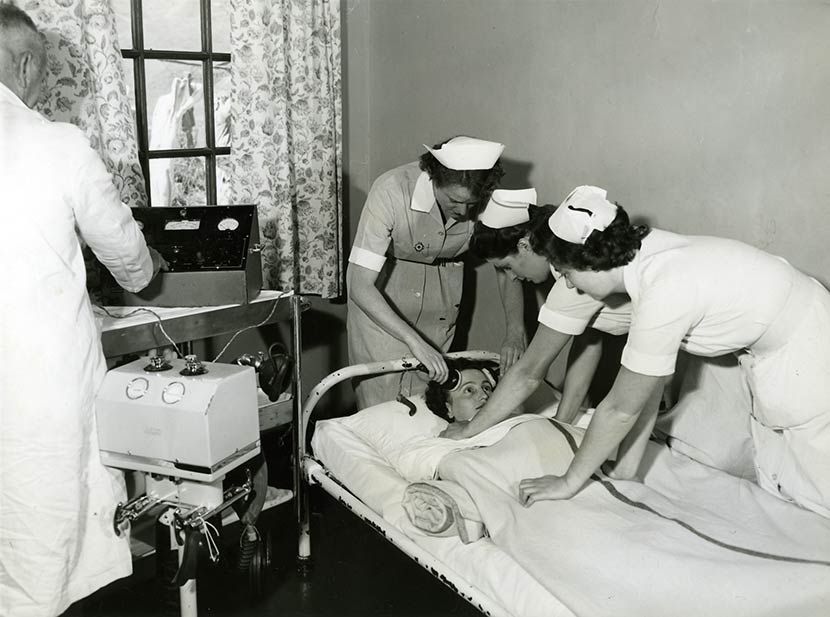The word “bedlam” originated from a British hospital. Surprising right?
But it’s true. It was the corrupted name for the Bethlem Royal Hospital in London, an asylum for the mentally ill that was created as early as 1247.
The word describes the utter chaos and inhumane conditions in the facility where patients were more or less treated as animals. This is one of the many stories that mirror the horrors of the primitive treatment of mental illness in the early days.
It was a period when insanity was seen as a spiritual issue. Patients would endure extreme pain and have holes drilled into their skulls to allow the tormenting demons to “escape.” But not anymore.
Humans saw mental health challenges as more of a spiritual issue than a medical one.
Mental health has indeed come a long way since then. It has gone from straitjackets to virtual therapy and from crude steel instruments to the peaceful services of meditation apps.
Let’s walk you through the dark and chilling history of mental health treatment. Here, we’d learn about the contributions that took insanity care from its barbaric old days to its present refined state.
You will be amazed to know how much has changed over the centuries, how far we’ve come from the regretful past where pain was disguised as progress.
The Dark Origins: Mental Illness Understood
The significant difference between insanity treatment in the past and now lies in the understanding of madness. The moment humanity began to solve this problem was when the journey to safe care began.

Initially, humans saw mental health challenges as more of a spiritual issue than a medical one. The more radical ones saw it as a moral failing.
So, either the affected person became a victim of spirits, or their condition was a well-deserved punishment for wrongdoing. Of course, these views influenced society’s response to the insanity problem.
Aside from making holes in patients’ skulls, mental health institutions conducted spiritual rites. Many patients were subject to grueling exorcisms and were even shamed in public.
Patients were tied down as electric currents passed through their bodies to provoke seizures.
But deep in Ancient Greece, one genius thought more deeply about the problem. After much reflection and study, the legendary philosopher Hippocrates began to believe that it was a product of an imbalance in bodily fluids.
Despite this, the terrifying treatment methods of the day continued to thrive. His voice and opinion were too faint to save the society from its madness.
The skull drilling, blood-spilling, rituals, and torture continued. The people added innovation to their ignorance. Hence, mental asylums emerged.
Asylums and Abuse: Houses of Horror
Mental asylums emerged in the 18th and 19th centuries. It emerged from a need to institutionalize and professionalize insanity treatment.
However, not much changed. Although it was a better arrangement than imprisonment, it failed to deliver on its promise of care and recovery, at least to a large extent.
Several activists championed this new system. At the forefront of this mental asylum proposal was a certain New Jersey-born nurse, Dorothea Lynde Dix.
She tenaciously lobbied the United States Congress as well as state lawmakers to facilitate the creation of these facilities. Her primary concern was that people with low incomes who were mentally ill received some of the worst forms of “treatment.”
Unfortunately, things didn’t turn out as many people expected. Or as Dix promised. Many mentally ill patients still went through harrowing experiences.
The treatment methods weren’t founded on a solid scientific background. Instead, they were desperate guesswork.
These included forced labor and isolation. It was also a popular practice to tie the patients with chains and other physical restraints. These were just a few of the many dehumanizing conditions they suffered.
One of the most notable mental health treatment practices at the time was “rotational therapy.” This involved fastening the affected persons to spinning chairs. The experts at the time believed that the practice helped realign the patients’ minds.
Another popular treatment technique was hydrotherapy. Here, asylum staff wrapped patients in wet sheets or strapped them to baths for many hours or a few days.
Most of the asylum practices focused on control rather than healing. The treatment methods weren’t founded on a solid scientific background. Instead, they were desperate guesswork.
Eventually, when the treatment methods became more scientifically advanced, they were still crude and horrific, just like the next treatment technique, based on electricity.
Electric Cures: Shocking Solutions
The 1900s ushered in a new treatment method involving electric shocks. It’s called “shock therapy.”

Its medical name is electroconvulsive therapy (ECT). When it emerged in the 1930s, it was well-received. Initially, it seemed like a ray of hope—a long-awaited breakthrough in psychiatric treatment.
Patients were tied down as electric currents passed through their bodies to provoke seizures. It was believed that this method was the answer to depression and schizophrenia. For the first time, they were right.
But still, the procedure was too crude, painful, and even dangerous. Many patients didn’t survive the brutality. A lot of them came out of the experience with broken bones. Others have memory loss. Unfortunately, some others never made it out. They died in the process.
Although the procedure helped to bring down violent behavior in many patients, it was hazardous and horrific.
One of the problems with ECT was that patients or their relatives were not informed about the procedure before it was carried out. The asylum staff would proceed at any time it felt necessary.
At the time, the procedure was hailed as a scientific advancement. Although the modern form of ECT is still being used alongside anesthesia, the 20th-century version isn’t something to be proud of.
Yet, there were more embarrassing procedures afterward. One of them is the lobotomy.
Lobotomies: The Ice-Pick Solution
Just when mental health treatment looked to become more humane, things got even worse. A new treatment called lobotomy came on the scene in 1935. It has now become the symbol of the cruel history of psychiatric treatments.
Lobotomy involves cutting the connection between the frontal lobe, a part of the brain that controls emotions, and the rest of the brain. It was a horrible surgery that continued for many years before it was banned.
To operate, an instrument that resembled an ice pick was inserted into the brain through the eye. The surgery was done without any other tools or sterilization.
It was Portuguese physician António Egas Moniz who developed the procedure. He even won a Nobel Prize for the discovery—an award that has remained a subject of criticism to date.
However, it was American doctor Walter Freeman who popularized the procedure. Dr. Freeman performed the surgery in his office and even drove to many homes to do it.
The introduction of much gentler treatment programs such as Cognitive Behavioral Therapy (CBT) completely changed the face of psychiatric care.
He had a van called the “Lobotomobile” with which he traveled. He also visited mental facilities to demonstrate the procedure to other physicians.
Dr. Freeman performed over 3,500 lobotomies. Many of them were done without consent or proper patient assessment.
Many of the patients, especially the younger ones as young as 12, became emotionless, permanently disabled, and unable to care for themselves afterward.
Although the procedure helped to bring down violent behavior in many patients, it was hazardous and horrific. Thankfully, not very long after, science discovered a less painful solution: Pills.
The Rise of Psychopharmacology: Pills Over Scalpels
The 1950s ushered in a ray of hope for psychiatric care. During this time, experts discovered and developed chemical treatments.
Notably, they found antipsychotic drugs. These were a perfect and humane alternative to ECT and lobotomies. They were especially helpful for patients with bipolar disorders and schizophrenia.

Finally, the perception about mental illness began to change. Many minds started to view it more from a medical perspective than from a spiritual one.
However, it wasn’t without its challenges. People began to rely too much on drugs. The medications also had some frightening side effects, such as involuntary movements.
Afterward, the society began to clamp down on the asylum facilities. The government started shutting down its operations in the 1960s. Many patients were reintroduced to society.
Now insanity is seen for what it truly is, an unfortunate condition that could affect just anyone.
This move, though long overdue, wasn’t well planned. Authorities didn’t put much in place to cater to the patients when they returned to society.
Many of them became homeless. Some slipped into addiction while others were removed from society and thrown into prison.
The lack of long-term planning meant that public mental health centers remained largely ill-equipped. The ones in existence were the top few and couldn’t accommodate every patient.
The scale quickly tipped from freedom to neglect. But it was a sign of progress. Things were going to get better from there, and they did.
Digitalization, Therapy and Talk: The Gentle Shift
Therapy was introduced into mental health treatment in the late 1900s. But it was reserved for the elite. It wasn’t until the late 20th century that it became accessible to the general public.

The introduction of much gentler treatment programs, such as Cognitive Behavioral Therapy (CBT), completely changed the face of psychiatric care. This was supported by the entrance of licensed psychologists, social workers, and counselors.
Enlightenment campaigns gained much ground. Experts began to educate society on mental illness. This succeeded in killing the stigma that people with mental challenges previously faced.
To spice things up, technology entered the picture in the 21st century. The digital mental health boom gained significant attention, sparking considerable excitement.
Now, mental health patients don’t have to visit medical facilities regularly to receive care. Apps such as Calm and BetterHelp have brought care into many homes.
This software supports therapy, meditation, and mood monitoring. There are mental health AI chatbots and online communication communities that provide impressive support to individuals in need of care.
Mentally challenged persons who cannot afford hospital or one-on-one treatment are no longer disadvantaged. They can get almost the same quality of care as long as they have a smartphone.
Remove the privacy issues and the lack of interpersonal connection, and this IT infrastructure is a significant leap in the evolution of mental health care.
From Cold Steel to Compassion
Across many centuries, humanity has undergone a significant shift in how it perceives mental health challenges. This shift in perception has also led to a crucial adjustment in treatment.
For many centuries, mentally ill persons have had to suffer pain and rejection, and added to that, they were seen as villains who were suffering for their sins or misdeeds.
Thankfully, society grew in knowledge and humanity. Now, insanity is seen for what it truly is, an unfortunate condition that could affect just anyone.
Reform after reform, we have transitioned from crude and cruel methods to more humane and compassionate techniques. We’ve moved from life-threatening care to safer and more humane methods. But a lot more still needs to be done.
As we continue to grow in empathy and technology, we will gain a deeper understanding of mental health and make more progress in treatment. To do this, we must always keep the lessons from our regretful history in mind.
An understanding of our past will give us new direction and extra motivation to reach out for a much brighter future. Which mental health treatment procedure did you find most disturbing?


